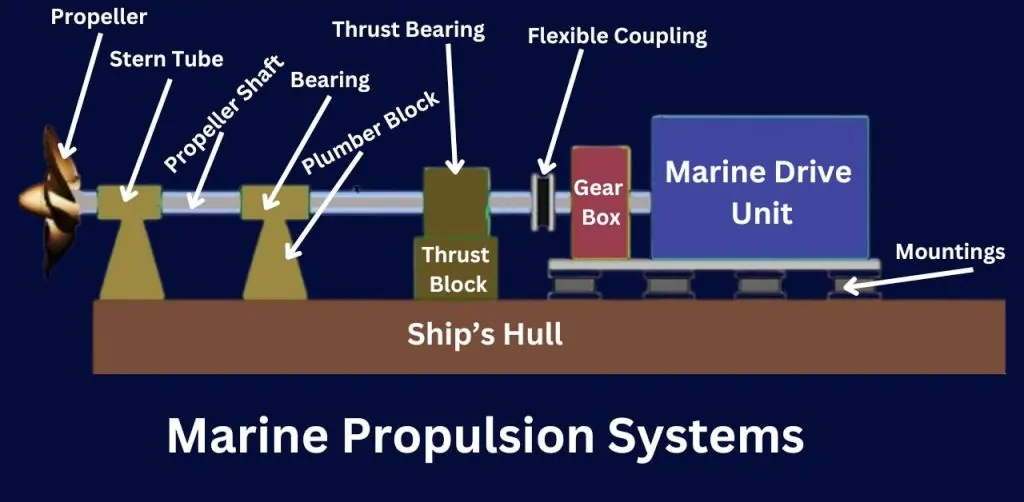Marine Propulsion Systems
Marine propulsion systems are essential for powering ships, converting engine energy into thrust to move vessels efficiently through water. These systems vary based on engine types, including diesel and gas turbines, but the core objective remains the same: to transmit power from the engine to the propeller effectively.
Efficient power transmission is critical for optimal performance, fuel efficiency, and the longevity of a ship’s machinery. Any disruptions or inefficiencies can lead to performance issues, increased fuel consumption, and costly repairs.
This post delves into the detailed process of how power is transmitted from the engine to the propeller, exploring key components such as the gearbox, shafting system, and propeller itself. By understanding the mechanics behind marine propulsion, engineers and marine professionals can ensure better operational efficiency and reduce the risk of mechanical failures. Whether you’re new to marine engineering or looking to enhance your knowledge, this guide will provide valuable insights.
Engine Power Generation
Marine engines play a vital role in providing the power necessary to propel ships. These engines primarily come in two types: Diesel engines and Gas Turbines. Diesel engines are commonly used in larger vessels due to their efficiency and durability, while gas turbines are favored for their higher power-to-weight ratio and speed.
Mechanical energy in marine engines is generated through combustion. In diesel engines, the combustion of fuel and air inside the cylinders creates high-pressure gas, which forces the pistons to move. This movement generates mechanical energy, which is then transferred to the crankshaft.
The crankshaft is a critical component in the power generation process. It converts the linear motion of the pistons into rotational energy, which is necessary to drive the ship’s propeller. This rotational energy, once converted, is transmitted through various systems, ultimately reaching the propeller and enabling the ship to move efficiently through water.
Power Transmission Components
Power transmission from the engine to the propeller involves several key components that work in harmony to ensure smooth and efficient operation. The main components in the transmission system are the gearbox, clutch, and shafting system.
- Gearbox: The gearbox plays a crucial role in reducing the high engine RPM to a suitable level for the propeller to operate efficiently. This reduction in speed ensures that the propeller can generate the necessary thrust without overworking the engine or propeller.
- Clutch: The clutch allows for smooth engagement and disengagement between the engine and the propeller. It ensures that power is transmitted only when needed, helping to protect the engine and transmission components from sudden jolts or excessive wear.
- Shafting System: The shafting system transfers the rotational power from the engine, through the gearbox and clutch, to the propeller. It is vital for maintaining alignment and transmitting power efficiently to the propeller.
Shafting System and Couplings
The shafting system is responsible for transmitting the rotational power generated by the engine to the propeller, playing a vital role in the overall propulsion process. The main shaft connects the engine to the propeller, transferring mechanical energy through the entire power transmission system.
To maintain proper alignment and power flow, couplings are used to connect sections of the shaft. There are two types of couplings:
- Flexible Couplings: These allow for slight misalignments between shaft sections, absorbing vibrations and reducing stress on the system, which helps in minimizing wear and tear.
- Rigid Couplings: These provide a strong, inflexible connection between shaft sections where precise alignment is critical. They ensure maximum power transfer without energy losses due to misalignment.
Shaft bearings are crucial in supporting the entire shafting system. They hold the shaft in place, reduce friction, and allow the shaft to rotate smoothly. Properly maintained bearings prevent misalignment, vibration, and wear, ensuring efficient power transmission and extending the lifespan of the propulsion system.
Reduction Gear Mechanism: The Best Guide for Marine Engines
Reduction Gear Mechanism plays a crucial role in marine propulsion systems by optimizing the speed between the engine and the propeller. Here’s how the mechanism works, types of reduction gears, and the benefits of using them in marine engines.
1. How the Gearbox Reduces Engine Speed for Optimal Propeller Speed
Marine engines typically operate at high speeds, which are not suitable for direct driving of the propeller. A reduction gearbox reduces the engine speed to match the optimal rotational speed required by the propeller for efficient propulsion. This process enhances the thrust generated by the propeller, which increases the ship’s overall performance. The gearbox works by employing gears of varying sizes to step down the engine’s high RPM to a lower, more efficient RPM for the propeller.
2. Types of Reduction Gears Used in Marine Propulsion Systems
There are several types of reduction gears used in marine engines, each with unique characteristics suited for different propulsion requirements:
- Single Reduction Gears: A simple gear arrangement that provides a one-step reduction in engine speed.
- Double Reduction Gears: Used in systems requiring more significant speed reduction. This setup involves two sets of gears to gradually lower the engine speed.
- Planetary Reduction Gears: A more compact and efficient gear arrangement, used in systems where space is a constraint, and higher power transmission is required.
- Helical Gears: Known for smoother and quieter operation due to the angled gear teeth, these gears are commonly used in marine applications for better efficiency and reduced noise.
3. Benefits of Using Reduction Gears in Marine Engines
Reduction gears offer several advantages in marine propulsion systems:
- Improved Fuel Efficiency: By reducing engine speed to match the propeller’s optimal RPM, reduction gears enhance the fuel efficiency of the marine engine.
- Extended Engine Life: Operating the engine at a reduced speed prevents excessive wear, which prolongs the lifespan of the engine components.
- Enhanced Propeller Performance: The reduced speed allows the propeller to operate in its most efficient range, providing better thrust and reducing cavitation.
- Noise Reduction: Proper gear selection, especially with helical or planetary gears, ensures quieter operation, which is vital for both passenger comfort and reducing underwater noise pollution.
Propeller Operation: The Best Guide for Marine Propulsion
Propeller Operation is a fundamental aspect of marine propulsion, directly affecting the vessel’s speed, maneuverability, and fuel efficiency. This guide explains how propellers convert rotational energy into thrust, the influence of propeller design on power efficiency, and the types of marine propellers commonly used in the industry.
1. How the Propeller Converts Rotational Energy into Thrust
A marine propeller functions by converting the rotational energy from the engine into thrust, propelling the vessel forward. As the propeller blades rotate, they create a difference in pressure between the front and rear sides of the blades. This pressure differential forces water backwards, creating a forward-moving thrust as per Newton’s Third Law of Motion (action and reaction). The efficiency of this process depends on the design of the propeller, the number of blades, and the blade angle, which directly affect how much water is displaced and the speed at which the vessel moves.
2. Propeller Design and Its Influence on Power Efficiency
The design of a marine propeller plays a crucial role in determining its power efficiency. Several factors influence this:
- Blade Shape and Size: Larger blades can push more water but may cause more drag, while smaller blades reduce drag but may require higher engine RPM to generate the same amount of thrust.
- Blade Pitch: The pitch refers to the angle of the blades, which determines how much water is pushed during each revolution. A higher pitch propeller moves more water with each rotation, making it ideal for faster speeds, while a lower pitch propeller is better for heavy loads.
- Number of Blades: Fewer blades generate less drag and are often more efficient for speed, while more blades provide better thrust for maneuvering and load-bearing but may reduce overall efficiency.
The right combination of these elements ensures optimal power transmission from the engine to the water, enhancing fuel efficiency and overall vessel performance.
3. Types of Marine Propellers
Marine propulsion systems use different types of propellers based on operational requirements:
- Fixed Pitch Propellers (FPP): These propellers have blades fixed at a set angle, meaning the blade pitch cannot be altered during operation. FPPs are simple, durable, and widely used in applications where consistent speed and direction are required. However, they are less flexible in adapting to changing operational conditions like varying speeds or loads.
- Controllable Pitch Propellers (CPP): The blade pitch in CPPs can be adjusted while in operation, offering greater control over thrust and power output. This flexibility allows for better maneuverability, efficiency, and fuel savings, especially in vessels with variable speed or load demands. CPPs are commonly used in vessels where frequent changes in direction or speed are needed, such as ferries or tugs.
What is Cavitation and How is it Formed on a Propeller?
What is Cavitation?
Cavitation is a phenomenon that occurs when the pressure on a liquid decreases to a point where vapor bubbles form, typically due to rapid changes in the fluid flow around an object, such as a propeller. When these vapor bubbles move into higher pressure areas, they collapse or implode violently, causing shock waves. This can lead to significant noise, vibration, and even physical damage to the surface of the propeller.
How is Cavitation Formed on a Propeller?
Cavitation on a ship’s propeller occurs when localized pressure on certain areas of the blade drops below the vapor pressure of water. Here’s how it forms:
- Pressure Differences on Blade Surfaces:
- A propeller generates thrust by pushing water backward, which propels the ship forward. This causes the pressure on the front side (leading edge) of the propeller blades to be higher, while the back side (trailing edge) experiences a lower pressure.
- When the pressure on the back side of the blade drops below the vapor pressure of the water, vapor bubbles begin to form.
- Vapor Bubble Formation:
- In these low-pressure zones, the water turns into vapor, forming tiny bubbles or cavities (hence the term “cavitation”). These vapor bubbles occur because the local pressure is insufficient to keep the water in its liquid form.
- Bubble Collapse:
- As the bubbles travel through the propeller’s rotation and enter areas of higher pressure, they collapse or implode.
- The implosion of these bubbles creates intense shock waves, which can erode the surface of the propeller blades over time, causing pitting and surface damage.
- High-Speed and Load Conditions:
- Cavitation is more likely to occur at high speeds or when a ship’s propeller is overloaded (e.g., operating beyond its designed capacity). These conditions exacerbate the pressure differences on the propeller blades, increasing the risk of cavitation.
- Consequences of Cavitation:
- Reduced propeller efficiency and loss of thrust.
- Increased vibration and noise.
- Long-term damage to the propeller, such as erosion, pitting, and blade fatigue, which can reduce its operational lifespan.
Transmission Efficiency and Maintenance: The Best Guide for Marine Systems
Transmission efficiency plays a crucial role in ensuring the smooth and effective operation of marine propulsion systems. This guide covers factors affecting transmission efficiency, the importance of regular maintenance for key components, and common problems along with preventive measures to maintain optimal performance.
1. Factors Affecting Efficiency in Power Transmission
Transmission efficiency in marine systems is the ratio of useful power output to the total input power. Several factors can affect this efficiency, including:
- Gearbox Design and Condition: The efficiency of a gearbox depends on its design, type of gears, and how well it is maintained. High-quality gears with low friction reduce power losses, while worn or misaligned gears increase inefficiency.
- Shaft Alignment: Proper alignment between the engine, gearbox, and propeller shaft is critical for efficient power transmission. Misalignment can lead to excessive vibrations, increased friction, and accelerated wear of components, reducing overall efficiency.
- Lubrication Quality: Insufficient or improper lubrication can lead to overheating and friction in gears, shafts, and bearings, significantly reducing transmission efficiency and causing damage to critical components.
- Propeller Condition: Fouling, damage, or improper sizing of the propeller can result in reduced thrust and higher fuel consumption, decreasing the efficiency of the entire propulsion system.
2. Importance of Regular Maintenance for Gearbox, Shafting, and Propeller
Routine maintenance is essential for sustaining high transmission efficiency in marine propulsion systems. Key components such as the gearbox, shafting, and propeller must be regularly inspected and maintained to avoid costly breakdowns and performance losses:
- Gearbox Maintenance: Regular inspection of gear teeth for wear, ensuring proper lubrication, and checking oil levels are essential tasks. Any abnormal noises, vibrations, or heat generation should be addressed immediately to prevent gear failure.
- Shafting Maintenance: Proper alignment checks, vibration analysis, and shaft seal inspections are vital to ensure smooth power transmission. Regular checks prevent misalignment and damage to bearings, reducing the risk of costly repairs.
- Propeller Maintenance: Propeller blades should be routinely inspected for damage, fouling, or imbalance. Cleaning and maintaining the propeller’s surface improves its hydrodynamic efficiency and reduces fuel consumption.
3. Common Problems and How to Prevent Them (Alignment, Lubrication)
Marine transmission systems are susceptible to several common problems that can severely impact performance and reliability. Below are key issues and how they can be prevented:
- Misalignment: Misalignment between the engine, gearbox, and shafting can lead to excessive vibration, noise, and component wear. Preventive maintenance includes regular shaft alignment checks and adjusting the position of components to ensure optimal alignment.
- Inadequate Lubrication: Poor lubrication can result in overheating, increased friction, and eventual failure of the gearbox, bearings, and shaft. Prevent this by using high-quality lubricants and following recommended lubrication schedules, along with monitoring oil levels and condition.
- Bearing Wear and Damage: Bearings are essential for smooth transmission, and excessive wear can lead to breakdowns. Regular inspection, proper lubrication, and replacing worn bearings promptly help prevent this issue.
Essential Formulas for Marine Propulsion and Shaft Mountings
1. Thrust Force (T)
The thrust generated by the propeller can be calculated using:
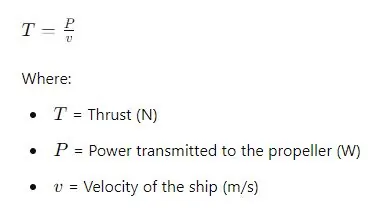
2. Torque (τ) on Propeller Shaft
The torque transmitted by the shaft can be determined by:
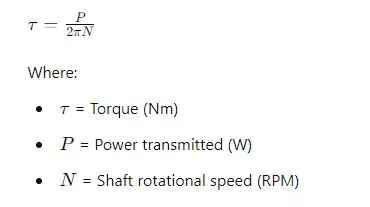
3. Power Transmitted by Shaft (P)
Power transmitted through the shaft is given by:
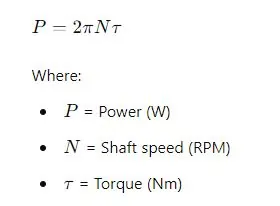
4. Shaft Bending Stress (σ)
The bending stress in the shaft due to the load can be found using:
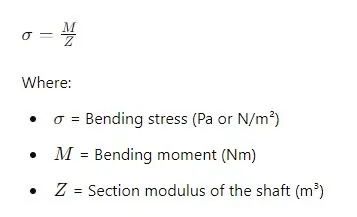
5. Critical Shaft Speed (Nₐ)
To avoid resonance, the critical shaft speed can be calculated by:
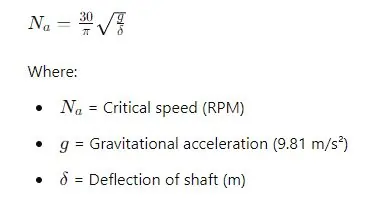
6. Radial Load on Bearings (F)
The radial load that the bearings (like plumber blocks) must support can be estimated by:
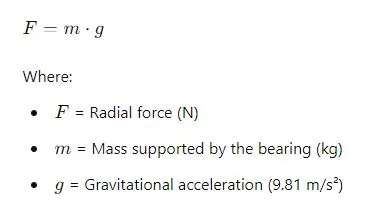
FAQ on Marine Propulsion Systems
Q- What are the different types of marine propulsion?
A- The main types are diesel propulsion, gas turbine, steam turbine, and electric propulsion.
Q- How does a marine propulsion system work?
A- It converts engine power into thrust through the propeller to move the vessel forward.
Q- What are the classifications of propulsion systems?
A- Propulsion systems are classified into mechanical, electrical, and hybrid systems.
Q- What is the power of marine propulsion?
A- The power varies based on vessel size, typically ranging from a few hundred kW to several MW
Conclusion
In summary, the power transmission process from the engine to the propeller is key to moving vessels efficiently, with the gearbox and shafting system playing vital roles in optimizing speed and thrust. For marine engineers, a solid understanding of marine propulsion systems is crucial for maintaining performance, troubleshooting issues, and ensuring environmental compliance. Looking ahead, advancements in hybrid systems, cleaner fuels like LNG and hydrogen, electric propulsion, and autonomous vessels are shaping the future of marine propulsion, driving greater efficiency and sustainability in the maritime industry.
